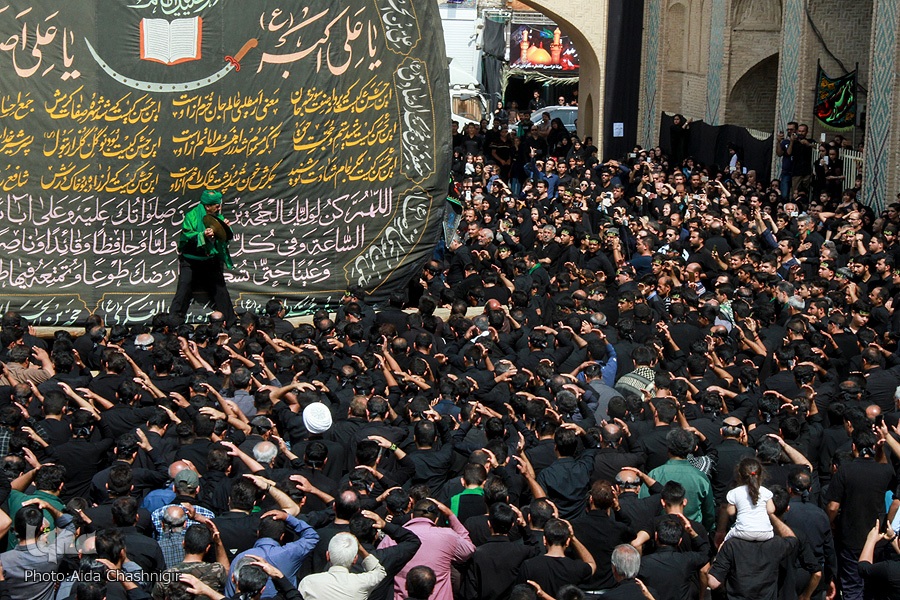Nakhl-Gardani, A Symbolic Funeral Procession for Imam Hussein (AS)

Muharram, the first month of lunar calendar, is the period of recalling and mourning the martyrdom of Imam Hussein (AS) by Shia Muslims communities.
Imam Hussein (AS), his family and his loyal companions, who were deprived of water for three days were eventually martyred by the army of Yazid I at the Battle of Karbala on Yazid’s orders on Muharram 10, known as the Day of Ashura. Ashura literally means the Tenth in Arabic.
Shia Muslims usually begin mourning from the first night of Muharram and continue for ten nights.
Various mourning ceremonies are performed during Muharram in different parts of Iran. Nakhl-Gardani is the one that certainly stands out.
Nakhl means palm tree in Persian language. It is a symbol of the coffin (casket) of Imam Hussein (AS), which is used during his symbolic procession ceremony.
Nakhl is a wooden structure shaped like a tree leaf. Nakhl, which resembles a chamber with a gabled roof, is covered mainly with black cloth.
Some days prior to the ceremony the Nakhl is decorated with small and large mirrors, knots and silk clothes tied at its sides. Mourners also decorate the symbolic coffin with myrtus leaves and other plants and flowers, photo frames of local martyrs, and colorful shawls.
The ceremony starts on the morning of Ashura when crowds of mourners set off for Hosayniyas (places used for religious mourning ceremonies) with the eulogists narrate the Ashura event and the life story of Imam Hussein (AS) and his companions.
Mourners, who are usually dressed in shades of black, beat on their chests according to the rhythm of a sung eulogy.
The procession walks, mourning and lamenting, a few kilometers to the Hosayniya. When they arrive at the Hosayniya the ceremony reaches its peak. As they enter the heart of the large crowd, they suddenly accelerate while approaching the Nakhl.
Nakhl is a hefty and massive structure; therefore mourners lift and carry it in big groups.
Crowd of mourners go under the Nakhl and lift it, along with those who had already settled there, all beating their chests with great weeping and wailing. They then walk around Hosayniya while carrying the Nakhl three or five times and finally put it back in its place.
Free drinks and food stuff (called Nazri in Persian language) will be distributed among the mourners as well.
The skeletons of Nakhls are usually kept in Hosayniya and mosques throughout the year.
The ceremony is registered on the intangible cultural heritage list of the country. In recent years, various organizations have made arrangements for the presence of foreign tourists in this event.

Origin of Nakhl-Gardani
There are various narrations to explain the reason behind naming the ceremony as such. The most probable one is that in the Karbala incident branches of palm tree were used to carry the body of Imam Hussein (AS).
The exact origins of this ritual are not known, but it is very likely that this method of mourning dates back to the Safavid era and the formalization of the Shia Islam in Iran.
While the ceremony is performed in Semnan, Damghan, Qom, Kashan, Abyaneh, Khor-Biabanak, Zavareh, Ardestan, Naeen and generally, cities and towns in the desert areas of Iran, the most conspicuous Nakhl-Gardani ceremonies are held across Yazd province on the Day of Ashura.
Yazd, the cradle of Zoroastrianism, is now one of the unavoidable points of Islamic Iran. The city is home to thousands of small and big mosques and Hosayniyas. It has earned the title “Iran’s and world’s Hosayniya”.
Observing such rituals and performing mourning ceremonies to commemorate Imam Hussein (AS) gather flock of people together reminding Muslim Unity. The gatherings also help narratives of the Battle of Karbala survive for the generations to come.



